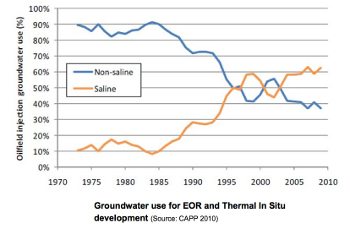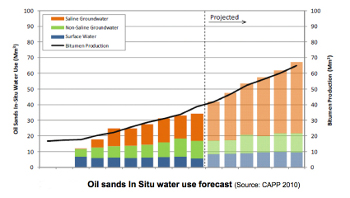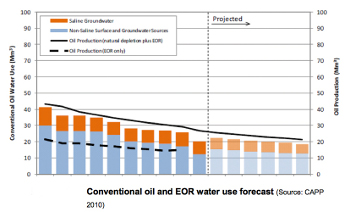What About The Saline water?
What about the Saline Water?
In addition to the non-saline groundwater that lies beneath our province, there are significant amounts of saline water within the deeper bedrock formations. Saline water in Alberta is defined as any water that possesses a mineralization (as TDS in mg/L) in excess of 4,000 mg/L. Although some of the saline waters have lower TDs values, making it economical to use as a total source or offset to fresh sources, much of this saline water has TDS values that far exceed the economic and environmental benefit of treating and using this supply source (energy and waste costs).
Therefore, only a certain portion of the provincial saline water resource can be accessed and used in support of development activities. Under the current economic and environmental setting, saline water with TDS values in excess of around 20,000 mg/L TDS is generally not considered viable as a useable or treatable supply source. This may change with time as commodity prices increase, and as technology to properly and safely deal with associated waste streams (treatment brine and associated salts) develop.
More and more businesses associated with the oil and gas sector are accessing saline sources of water to support production activities. The chart (right) demonstrates how increasing use of saline water use to support enhanced oil recovery (EOR) operations and in situ thermal oil sands development has manifested itself over recent years. Since about 1997, the percentage of water used to support these industries has dominantly been sourced from saline water-bearing formations.
A significant proportion of the water used to support oil and gas development relates to the oil sands sector. This includes both mining, which relies on surface water (primarily from the Athabasca River) to process the oil sand deposits situated close to surface and in situ thermal recovery operations, which are more reliant on groundwater to produce the steam required to mobilized the bitumen in place for recovery to surface.
Over the years, the use of saline water to support development activities in Alberta has been increasing. Much of this shift away from fresh water has been driven by Alberta Environment’s desire to reduce the amount of fresh water use in support of economic development. As such, the oil and gas sector has been a leader in the retooling of water use in our province.
According to the Canadian Association of Petroleum Producers (CAPP), anticipated future trends with respect to surface water and non-saline groundwater used to support in situ thermal operations are projected to stabilize or increase only slightly, with continued and increased development of saline source to provide the water required for operational needs (see chart – left). This is an encouraging trend toward the goal of reducing non-saline water use in the oil and gas sector.
In contrast to the growing non-conventional oil sector, the water profile for the conventional and enhanced oil recovery (waterfloods) in Alberta shows a reducing trend, and has been for some time now. The chart (right) shows the recent trajectory of non-saline and saline water use associated with these activities, and the projection out to 2015. The indications are for a continued decline in conventional and EOR use of non-saline and saline sources with the continued maturing and reduced production from the oil-producing formations.
Because water use is important to the successful and economical production of oil and gas – one of Alberta’s major industries – it is important to remember that economic benefit to the province is being gained through its use to support this activity. Continued efforts in recycling, and the continued increase of saline water use in place of non-saline sources, is an evolution towards more sustainable use of our provincial water supplies.
However, considering the volumes of more easily-accessed (and economical) non-saline groundwater beneath our province, the question must be asked:
“What are we saving all this useful and economical groundwater for, if there are more than sufficient supplies in place to ensure ecosystem health, and safe/secure/reliable supplies for the population of Alberta?”
To date, no quantitative study of the saline groundwater beneath Alberta has been conducted. However, it is safe to say that the resource is likely large, and in excess of the volumes of non-saline water residing beneath our feet. Considerable information resides with agencies like the Energy Resource Conservation Board (ERCB) that could support the completion of such an inventory, if deemed useful. Unfortunately this information is not centralized (like many other data sources in Alberta), which complicates such an effort. Nonetheless, as the reliance on saline water sources increases, the need to conduct a proper inventory of this resource, and where it can economically be accessed for use, will increase.
Section 2: Alberta’s Water Balance and Inventory
Module 1: What do we know about groundwater today?
Module 2: How important is groundwater to Albertans?
Module 3: How much groundwater is there?
Module 4: Where’s the “good” water?
Module 5: What about the saline water?



